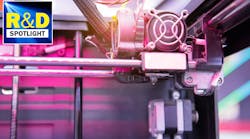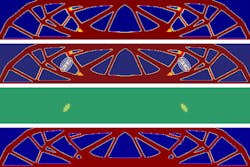R&D Spotlight: Defect Detection in Metal 3D Printing, Multi-Metal Design, Plus a Novel Design Approach
At a Glance:
- Using X-ray beams and machine learning for detecting structural defects, such as pore formation, can help prevent failure of metal 3D-printed parts.
- Systematic computer-based material design uses computational prediction to figure out material properties for optimized 3D parts.
- Design and prototyping approaches that include input from design engineers prove to be more effective at design optimization than an automated system working alone.
The purpose of emergent technologies is nothing more than to make new things that are better than what came before. Experiments in academia and R&D trials of today are the real-work 3D printing solutions of tomorrow. In this briefing, we narrow the scope to three ideas in the pipeline.
1. Real-Time Defect Detection in Metal 3D-Printed Parts
Structural defects that form during the additive manufacturing building process are commonly identified as a SNAFU that prevents metal additive manufacturing techniques from widespread adoption. Now a new method for detecting and predicting defects looks at using various imaging and machine learning techniques to detect and predict the formation of pores in 3D-printed metals in real time with near-perfect accuracy.
The method was recently published in the journal Science by a research team led by the U.S. Department of Energy’s (DOE) Argonne National Laboratory and the University of Virginia (UVA). In this study, laser powder bed fusion (LPBF) was used to create metal samples. LPBF is a rapid prototyping technique that uses a source of heat to melt metal powder and generate a desired metal part.
LBPF can lead to the formation of pores that can compromise a part’s performance. Even though additive manufacturing machines are equipped with thermal imaging sensors that monitor the build process, they miss the formation of pores. The research team chalked up this shortcoming to the fact that sensors only image the surface of the parts being constructed.
READ MORE: Finding an Additive Manufacturing Solution
The way to directly detect pores inside dense, metal parts, they noted, is to use intense X-ray beams, such as those generated by the Advanced Photon Source (APS), a DOE Office of Science user facility at Argonne. “Our X-ray beams are so intense that we can image more than a million frames per second,” reported Samuel Clark, an assistant physicist at Argonne.
The APS method of detection allowed the researchers to see pore generation in real time, as well as to observe distinct thermal signatures at the surface (detected with thermal cameras).
Additionally, the researchers used a machine learning model to predict the formation of pores within 3D metals using only thermal images. They validated the model against data from the X-ray images. Finally, they tested the model’s ability to detect thermal signals and predict pore generation in unlabeled samples.
“The APS offered the 100% accurate ground truth that allowed us to achieve perfect prediction of pore generation with our model,” said Tao Sun, an associate professor at UVA.
What’s promising about the approach is that it can be readily implemented in commercial systems, noted Kamel Fezzaa, a physicist at Argonne. “With only a thermal camera, the machines should be able to detect when and where pores are generated during the printing process and adjust their parameters accordingly,” Fezzaa said.
That means not only that a major defect can be detected early in the manufacturing process, but also that the machine can automatically stop building a part. To boot, the approach saves inspection time. The ultimate goal, the researchers noted, is to create a system that not only detects defects, but repairs them during the manufacturing process.
2. Multi-Material Computer-Based Design will Take 3D Printing to the Next Level
Additive manufacturing methods provide countless opportunities for integrating customization and functionality into a single printing process. Yet, AM remains limited by the types of materials to be used in one component.
MADE-3D (Multi-Material Design using 3D Printing), a project backed by the European Union’s Horizon Europe 2022 program, hopes to increase performance and reliability of muti-material components that will at once create opportunities for lightweighting.
READ MORE: Additive Manufacturing Drives Resilience, Adaptability and Innovation in 2023
One way to achieve their goals is to focus on the design phase of product development. Using systematic computer-based material design, the MADE-3D experts can calculate and predict the desired material properties for an application based on the chemical composition. This process-development method uses machine learning and enables users to optimize material combinations for multi-material candidate within two or three iterations.
The use of ML is expected to reduce development cycles and promote the digitalization of the process chain. The project leans on both laser powder bed fusion (LPBF) and direct energy deposition (DED) to enable the atomized material combinations for 3D printing and produce high-quality components.
The consortium behind the MADE-3D project consists of an international team of research institutions, additive manufacturing market leaders, the aerospace industry, automotive engineering and start-ups. The project recently received funding of around €6.7 million ($7.2 million) for the next three-and-a-half years, and initial findings are expected in six months’ time.
3. MIT Researchers Tinker with a New Design Approach
Researchers at MIT combined an automated design system with the skills of human engineers to develop a method that uses the best attributes of the two design approaches. The resulting methodology, they said, optimizes designs for both visual and mechanical properties.
In a paper published in Structural and Multidisciplinary Optimization, MIT doctoral student Dat Ha and assistant professor of civil and environmental engineering Josephine Carstensen describe how they set out to design a number of structural load-bearing beams that might be used in constructing a bridge or building.
The process, called Human-Informed Topology Optimization, begins with feeding the program specifications. As the structure evolves, the engineers interrupt the design and ask the user to evaluate the structure for potential weaknesses and to adjust the parameters according to their preferences. The algorithm takes the updated features and input into consideration and revises the design by strengthening and compensating struts.
The basic approach can be applied to a broad range of designs and industries—from biomedical devices and nanoscale materials to structural support members of a skyscraper, noted Carstensen. In the automotive and aerospace industries, where lightweighting and structural integrity are key considerations, the use of automated design systems is becoming ubiquitous.
READ MORE: Some Simple DFMA Magic for Sheet Metal
In some cases, where internal components that aren’t visible, appearance is irrelevant, but for other structures aesthetics may be important as well. The researchers said that the new system allows the user to optimize designs for visual as well as mechanical properties—and in such decisions the human touch is essential.
While the current results are not yet ideal, Carstensen maintained that “a fully rigorous yet significantly slower design algorithm that considers the underlying physics,” would be better than a result generated by an automated design system alone. The system has demonstrated that the approach can be efficient at reducing design time and optimizing a design based on specific properties and additionally has the potential to change the way engineers tackle design tasks.
Development on a full 3D version is ongoing. Meanwhile, a basic two-dimensional version of the software, suitable for designing basic beams and structural parts, can be downloaded for free.
References
Ren, Z., et al. (2023) "Machine learning—aided real-time detection of keyhole pore generation in laser powder bed fusion." Science.
Ha, D.Q., Carstensen, J.V. "Human-Informed Topology Optimization: interactive application of feature size controls." Struct Multidisc Optim 66, 59 (2023).


